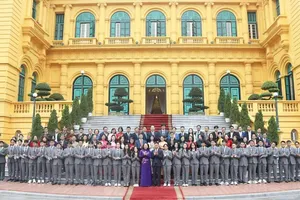
The 2018 General Education Program introduces several new features. For instance, high school students are now required to select subject combinations starting from grade 10, and the graduation exam now include information technology and technology. As a result, career guidance and university admissions counseling have been adjusted to provide timely support to these students.
Deputy Director Nguyen Thi Kim Phung of the Admissions and Business Relations Center at Ho Chi Minh City University of Finance and Marketing emphasized the necessity of early career counseling in high schools due to changes in the new General Education Program. She advocates for this guidance to begin as students enter grade 10, enabling them to make informed decisions about their subject combinations in line with their abilities and career aspirations.
Director Pham Doan Nguyen of the Center for Skills Development and Career Guidance, University of Economics and Finance, Ho Chi Minh City, said that with the changes in the new general education program, it is necessary to implement specialized career guidance programs for students, apply digital technology in counseling, strengthen online counseling programs of universities, professional units, reputable media units with a team of experts with high understanding and expertise in the profession to advise and orient careers close to each student.
It is important that high schools must help students visit and experience real-life careers, experience vocational training at universities.
Director Pham Doan Nguyen of the Center for Skills Development and Career Guidance at the University of Economics and Finance in Ho Chi Minh City highlighted the need for specialized career guidance programs due to changes in the new general education program. He emphasized the importance of integrating digital technology in counseling, bolstering online counseling efforts from universities, professional organizations, and reputable media units with highly knowledgeable experts.
Last but not least, he supposed that high schools should facilitate students’ visits to real-life workplaces and vocational training at universities, ensuring career guidance is tailored to each student's needs and aspirations.
Observing the management reality, Tran Duc Hanh Quynh, Deputy Head of the Division of Education and Training of District 1, noted the challenges in student orientation due to the district's central city location. Many parents prefer their children to attend university or college, believing that students are too immature for vocational schools immediately after junior high or even after high school graduation.

Some argued that vocational schools still use outdated curricula that fail to meet societal needs, making it difficult for vocational students to find jobs after graduation. As a result, they feel compelled to pursue a university education for better job prospects. To effectively implement the student streaming policy, career counseling must involve a collaborative effort from schools, families, society, businesses, authorities, and organizations.
Educational institutions need to regularly organize psychological counseling, career education and student streaming orientation activities before, during and after the public tenth grade entrance exam, thereby helping students to be aware of their professions early to determine their direction and learning path from the end of junior high school.
Based on data from the Ministry of Education and Training, the proportion of university students pursuing STEM (science, technology, engineering, mathematics) in Vietnam is only around 55 students per 10,000 people, which is significantly lower than that of other countries in the region and Europe. The percentage of university students studying STEM fields in Vietnam has varied between 27 percent and 30 percent in recent years.
In Vietnam, only around 1.5 percent of students study natural sciences and mathematics, which is significantly lower compared to Finland, Korea, Singapore, and Germany. This percentage is just one-third of Finland's, one-fourth of Korea's, and one-fifth of Singapore's and Germany's.
Meanwhile, the scale of training in economic sectors is very large. Commenting on this situation, lecturer Nguyen Tien Dung, former Head of Training Department, Ho Chi Minh City University of Technical Education, said that the trend of students choosing majors in Vietnam now is very similar to many countries in the world and in the region many years ago. This also reflects the law of supply and demand, if society has a need, students will continue to study.
Candidates often overlook the importance of evaluating whether the major they select is currently in demand, as well as its projected relevance upon their graduation in approximately four to five years. The concern lies not with the candidates themselves, but rather with the education sector, which frequently neglects comprehensive career guidance or addresses it only in a cursory manner. Effective career guidance is not a task that can be accomplished in a short timeframe.
Representatives from various universities assert that for career guidance to be genuinely effective and impactful, there must be a collaborative effort among general education, higher education, and vocational training. A systematic approach to career guidance is essential, involving knowledgeable professionals and the development of scientifically-informed career guidance programs to ensure that students are appropriately and effectively directed in their career paths.
























